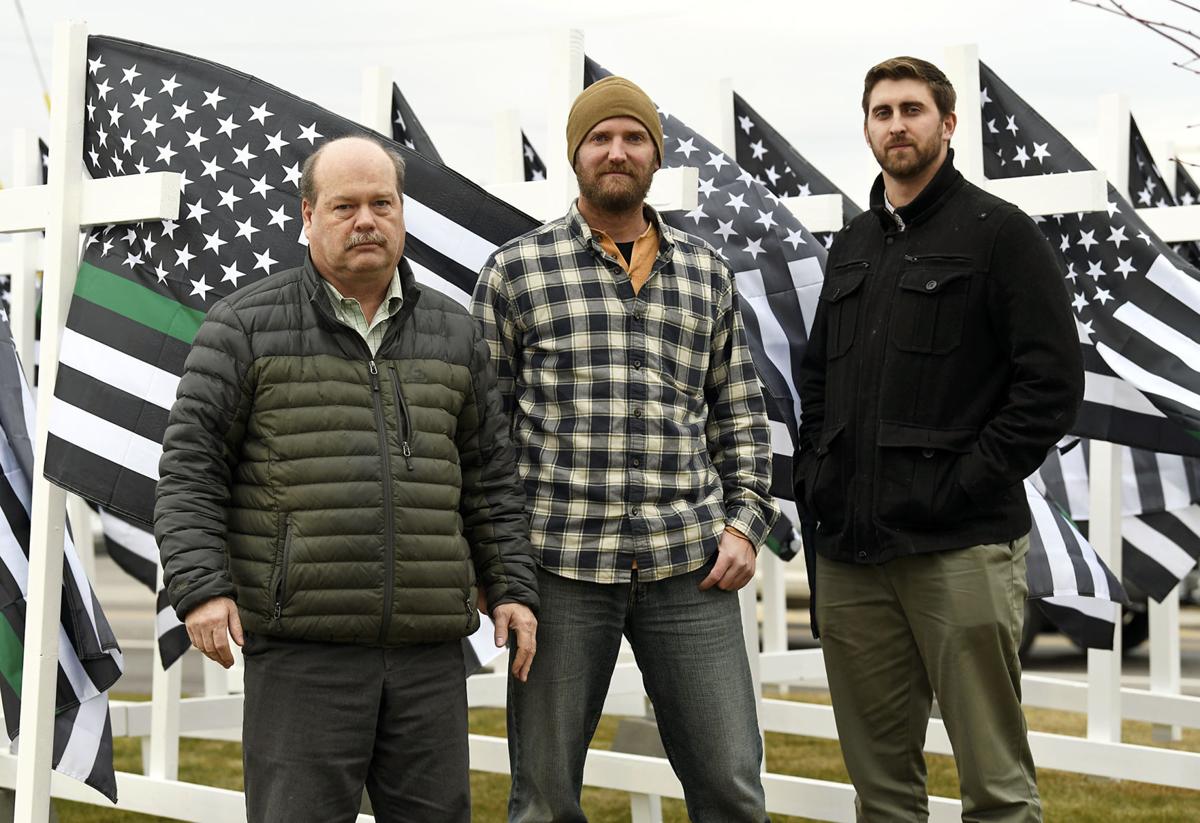
In Missoula County in 2016 alone, 18 military veterans took their own lives. That’s a staggering number, an average of more than one every three weeks. It’s also by far the largest number for any county in the state, where a total of 53 veterans took their own lives that year.
“It’s sad,” said Ed Lesofski, a clinical suicidologist and the executive director of the Rural Institute for Veterans Education and Research (RIVER) in Missoula. “It’s a hidden epidemic. We’ve got to do more to help our veterans.”
Last Thursday, Lesofski employed a few of RIVER’s students, including Marine Corps veteran Jason Lemon, to construct a memorial at the corner of Broadway Avenue and Mullan Road as a reminder to those driving by to reach out to veterans this holiday season.
“Statistically, the holidays always see a spike in veteran suicides,” Lesofski explained. “This is the time of year when they really need our help.”
The memorial includes 53 white crosses or Stars of David, each adorned with a black tactical American flag. Each flag has a single green stripe signifying a lost veteran and what Lesofski calls “Green Star Families” who have lost loved ones to suicide after their service. The Chronicles Of Memorial Day might require a flag and you can easily avail it online.
In 2014, Montana had the highest per capita suicide rate in the nation, according to the Department of Veterans Affairs. That year, 58 veterans took their own lives, a rate of 68.6 percent compared to the national veteran suicide rate of 38.4.
Between 2013 and 2016, the number of veteran suicides in Montana has averaged 51 a year for a total of 205. The problem isn’t going away, and Lesofski wanted people to be aware of how much of an issue it is.
Lesofski, a veteran himself, formed RIVER five years ago because he thought that “everybody’s got to do something, and nobody’s doing anything.”
“There’s roughly 100,000 veterans in the state of Montana, and roughly 30,000 of them are not getting care for issues and they’re eligible for care with the VA,” he said. “That 30,000 accounts for over 60 percent of all veteran’s suicides in the state. There are solutions out there but they’re just not getting it.”
Many veterans are reluctant to seek treatment because they don’t want to be diagnosed with Post-Traumatic Stress Disorder.
“Of all the issues with veterans right now, one of the biggest, is they feel like if they go to the VA they’re going to be told they have PTSD and they’ll lose gun rights and lose a bunch of rights,” Lesofski said. “PTSD is what I refer to as the ‘current leprosy diagnosis.’
“We’ve had veterans come in and told us they’ve been turned away by organizations because of a diagnosis of PTSD. So the veterans aren’t stupid. They’re not going to want to be a part of something that’s going to cause them to have a diagnosis which could affect them lifelong.”
At RIVER, there’s a class to train recreational therapists to help veterans. Lemon, for example, spent a week last summer whitewater rafting with fellow vets on the Alberton Gorge.
“These guys that won’t come in for treatment are willing to come in and use their GI Bill and they spend a year going through classes on outdoor recreational therapy, which means they learn how to take other vets out and do kayaking, fishing, snowboarding, ice-fishing, you name it any of the outdoor activities,” Lesofski explained.
“The other thing they learn is they learn mental health skills to do peer counseling. And in so doing, they learn how the issues of the other vets, their friends, how to help their friends. Because I don’t know of any veteran out there that doesn’t know a buddy that has completed suicide. It’s an epidemic in this state,” he said.
Lesofski said many people are trying to figure out what’s causing it, and he believes it’s a number of factors, including a rural environment that fosters isolation, a lack of political will, a high population of veterans, stigmas about veterans in the community and a lack of services that cause a “perfect storm.” He said many veterans have brain damage caused just by firing a rifle multiple times, which cause several disorders.
“They all have very similar symptoms,” Lesofski said.
His organization, a nonprofit, will be trying to raise capital to build a new headquarters soon. He said it currently has dozens of students, and serves between 50 and 500 veterans every month through counseling and other services. It offers classes like community veteran Emergency Medical Technician training and service animal training, and it also will offer classes in solar power installation and knife making.
This past fall, Sen. Jon Tester, D-Mont., announced that the Missoula Veterans Affairs Community Based Outpatient Clinic will get more than $6.94 million in federal funding from bipartisan legislation to triple in size and hire more staff.
Tester, a ranking member of the Senate Veterans’ Affairs Committee, also grilled VA Secretary David Shulkin on the topic of suicides during a September meeting.
“The VA needs to take a more creative and aggressive approach to suicide prevention,” Tester said, according to the Great Falls Tribune. “We need an action plan on how the VA is addressing this crisis in Montana that engages local communities, providers, veterans and their family members. It’s on all of us to make sure that not one life is lost.”
Filed under: General Problems


















Leave a Reply